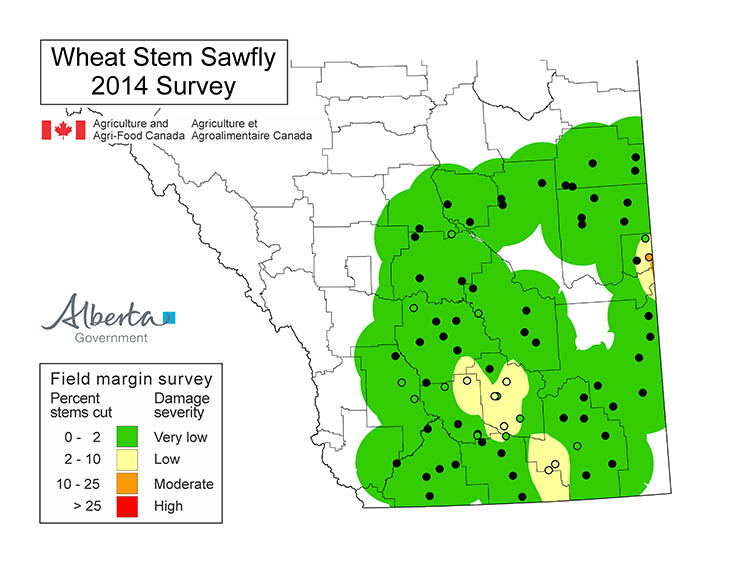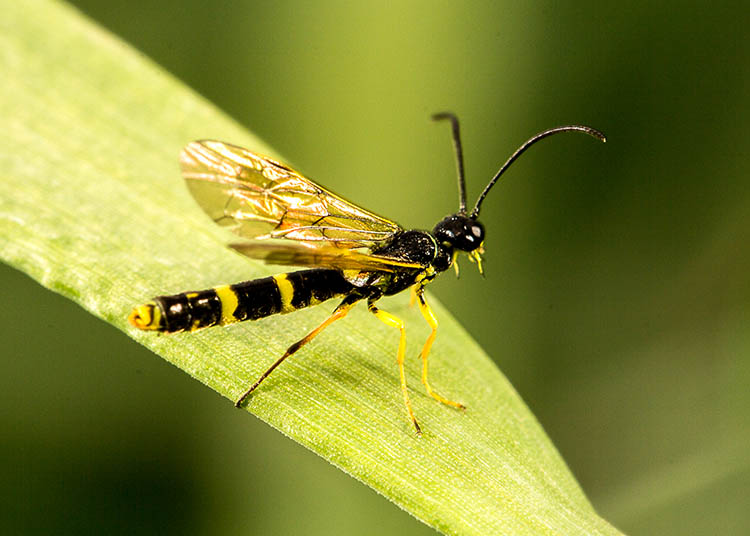| |
2015 Wheat Stem Sawfly Forecast | |
| |
|
|
| |
|
|
| |
 . .
The area at risk of economically significant sawfly populations in 2015 will be limited to only a few areas. The 2014 field margin survey shows low populations in most of the area surveyed including the traditional sawfly areas in the Special Areas and the County of Forty Mile.
The damage ratings are based on 75 fields in 16 municipalities.
One field was found with a moderately elevated sawfly infestation in the MD of Acadia.
Seven other fields were found with elevated but still low sawfly numbers in the counties of Lethbridge and Forty Mile and the MD of Taber. Overall the sawfly concern remains very low. |  |

The Wheat Stem Sawfly Map is based on cut stem counts conducted after the 2014 harvest. |
There are sufficient numbers to fuel wheat stem sawfly resurgence if dryer conditions occur for several consecutive years. Despite the low level of sawfly in the survey, individual fields may still have higher wheat stem sawfly populations than are indicated in the survey map. Overall there were zero or very low sawfly numbers in 67 of 75 (89%) of fields surveyed. (Field locations denoted by a black dot had zero sawfly found in the survey.)
The percent of stems cut by sawfly gives an indication of the number of reproductive adult sawflies that will emerge in late June through early July. Winter conditions have very little impact on sawfly populations and a high proportion of wheat stems cut in the fall will produce adults. Producers in areas with moderate to high levels of cutting should consider using solid stem wheat as a control strategy.

Wheat stem sawfly | Female sawflies lay eggs inside grass and grassy crop stems; the eggs hatch and tunnel inside stems until the crop starts to dry down near harvest. As the crop starts to ripen the sawfly larva migrates to the stem base and cuts a notch most of the way through the stem. Feeding damage from the tunneling can result in hidden yield losses of 10 to 15 percent. Further yield losses can occur from lodging at harvest. More information can be found at wheat stem sawfly life cycle.
|
It is possible that population hot spots still exist in areas of lower risk, individual producers need to be aware of the potential risks in their own fields.
Cutting levels higher than 10 to 15 percent in the previous crop indicate the need to consider seeding solid stem wheat to reduce sawfly losses. It is important farmers evaluate their individual situations in making their variety choices. When populations are low it is typical to have small localized populations of sawfly that affect only one field or even just a portion of one field.
The 2014 wheat stem sawfly survey was done by Alberta Agriculture and Rural Development with support from Farming Smarter and Chinook Applied Research Association. Thank you for your contribution.
Thank you David Giffen, Agriculture and Agri-Food Canada, Saskatoon for building the map.
For more information of sawfly and their management contact the Ag-Info Centre at 310-FARM (3276).
|
|
| |
|
|
| |
For more information about the content of this document, contact Scott Meers.
This document is maintained by Shelley Barkley.
This information published to the web on December 3, 2014.
Last Reviewed/Revised on January 5, 2015.
|
|